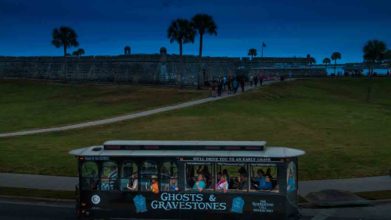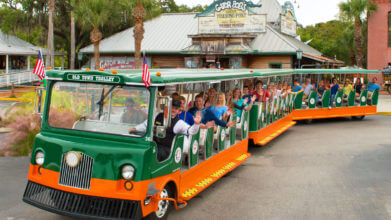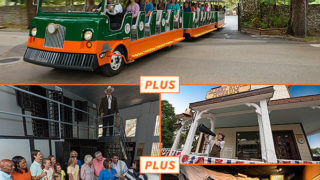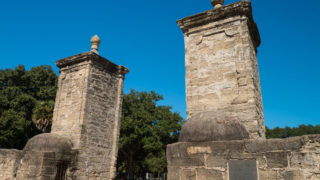History

The History of St. Augustine
Over the past 450 years, St. Augustine has grown from a fledgling European settlement and military outpost ridden with violence and turmoil to Henry Flagler’s Gilded Age in the late 1800s. Today, the historic city lays claim to one of Florida’s up-and-coming cultural hubs with a vibrant art and music scene.
St. Augustine is often described as a city frozen in time, and with good reason. Founded in 1565 by Spanish explorer Don Pedro Menéndez de Avilés, it holds the title of the oldest continuously inhabited European-established settlement in the continental United States. Over the centuries, it has been shaped by a series of complex events and cultural exchanges, leaving behind a rich and layered legacy.
The story of St. Augustine history is filled with moments of exploration, colonization, conflict and change. Visitors can still walk along the narrow streets first laid out during the Spanish colonial era and visit buildings that date back hundreds of years. From the defensive walls of the Castillo de San Marcos to the art-lined stretch of Aviles Street, the city offers countless opportunities to connect with the past.
Today, the history of St. Augustine lives on through its architecture, its museums and the stories shared by local guides. It is a city that invites visitors to slow down and experience the events that helped shape not only Florida but the broader history of the United States.
Founding
The history of St. Augustine begins in 1565 when Spanish Explorer Don Pedro Menéndez de Avilés arrived on Florida’s northeastern coast. Acting under orders from King Philip II of Spain, Menéndez came to establish a permanent Spanish settlement and defend Spain’s claims against rival European powers. He chose a coastal area that offered both strategic protection and access to inland waterways. This settlement would become St. Augustine.
Built on land inhabited by the Timucua people, the city was founded to serve as both a military stronghold and a center for missionary work. From its earliest days, St. Augustine was part of Spain’s broader effort to expand its empire in the New World. It also became an important base for defending Spanish ships traveling along the Atlantic trade routes.
The city’s early years were marked by challenges. St. Augustine faced frequent attacks, shortages, and tensions with local Native American groups. Still, the settlement endured. Its success marked the beginning of an enduring Spanish presence in Florida, and it laid the foundation for centuries of cultural and political influence.
As the oldest city of its kind in the continental United States, the founding of St. Augustine remains a pivotal chapter in American history. It set the stage for what would become a deeply layered story of survival, adaptation and global significance.
European Settlement
Following its founding in 1565, St. Augustine quickly became a vital center of European activity in the New World. As Spain worked to expand its influence throughout the Americas, the city served as a military outpost, mission base and trade hub. Over time, it grew into a focal point of European settlement in what is now the southeastern United States.
The Spanish introduced their architecture, religion, language and agricultural practices, establishing a long-lasting cultural imprint on the region. Catholic missions were built to convert the local Timucua people, and churches, homes, and administrative buildings took shape using coquina stone, a locally quarried material that still defines much of St. Augustine’s architectural character today.
Life in early St. Augustine was shaped by frequent challenges, including pirate raids, territorial disputes with other European powers and harsh living conditions. In 1586, English Privateer Sir Francis Drake attacked the city and burned much of it to the ground. Spain responded by reinforcing its defenses, which eventually led to the construction of the Castillo de San Marcos in the 1670s.
Throughout the 1600s and 1700s, St. Augustine remained a key Spanish stronghold despite frequent skirmishes with the British and pressure from French interests in the region. The settlement changed hands several times, but its early role in the St. Augustine story cemented its identity as a city shaped by resilience, colonial ambition and cultural exchange.
Today, remnants of these centuries-old efforts still stand. Visitors walking through the historic district can see the lasting influence of European settlement, from narrow alleyways and original city gates to enduring traditions that reflect the city’s Spanish roots and continued importance in the history of St. Augustine.
19th-Century Elite Retreat
By the late 1800s, St. Augustine entered a new chapter in its long and storied past. What was once a strategic outpost became a fashionable winter retreat for some of the country’s wealthiest families. This transformation was largely led by Henry Flagler, an industrialist and co-founder of Standard Oil, whose investments forever changed the look and feel of the city.
Flagler recognized that St. Augustine’s warm climate, coastal beauty and historical atmosphere made it an ideal destination. In 1888, he opened the grand Ponce de Leon Hotel, a stunning example of Spanish Renaissance Revival architecture that now serves as the heart of Flagler College. He followed it with the Alcazar Hotel, now home to the Lightner Museum, along with several other developments that brought modern luxury to the city. His work included upgrading roads and expanding the Florida East Coast Railway, making travel easier and more appealing for affluent northerners.
These efforts helped shape a new identity for the city. What had once been a colonial settlement became a social hub filled with public gardens, ornate buildings and upscale amenities. The presence of seasonal visitors brought new businesses, cultural institutions, and a wave of prosperity that would leave a lasting imprint.
Today, many of the structures built during this period still stand. Walking through the historic district offers a glimpse into this era of elegance and reinvention. This moment in St. Augustine history introduced a fresh wave of growth, turning the city into a destination not just for its past but also for its beauty and hospitality.
Key Moments in St. Augustine History
The story of St. Augustine unfolds across centuries shaped by military conflict, political shifts and cultural transformations. Each of the following moments represents a significant point in the broader history of St. Augustine:
1565 – Spanish explorer Don Pedro Menéndez de Avilés establishes St. Augustine, marking it as the oldest continuously inhabited European-established settlement in the continental United States.
Late 1500s – Fort San Juan del Pinillo is built to help protect the growing settlement. Though it no longer stands, it represents the city’s early focus on defense and survival.
1586 – English Privateer Sir Francis Drake attacks the city, looting and burning much of it during a raid that highlights the vulnerability of colonial outposts.
1672-1695 – The Castillo de San Marcos is constructed from coquina stone, offering stronger protection and becoming one of the city’s most enduring and iconic landmarks.
Early 1700s – St. Augustine faces repeated attacks from British forces and their Native American allies, pressuring the Spanish defenses.
1740 – James Oglethorpe, founder of the colony of Georgia, launches a siege on the city. The attack fails, but the episode underscores the region’s contested status.
1763 – After the French and Indian War, Spain cedes Florida to Great Britain in exchange for Havana. St. Augustine becomes the capital of British East Florida.
1783 – With the end of the American Revolutionary War, the Treaty of Paris returns Florida to Spain. St. Augustine resumes its role as a Spanish colonial city.
Early 1800s – Political tensions and border disputes continue during the Second Spanish Period as empires struggle for control across the region.
1821 – Under the Adams-Onís Treaty, Spain formally transfers Florida to the United States. St. Augustine becomes part of a new nation and begins its American chapter.
Late 1800s – Henry Flagler transforms the city into a luxury resort destination, building hotels, transportation networks and public spaces that draw travelers from across the country.
Mid-1900s – St. Augustine plays a visible role in the Civil Rights Movement. Demonstrations, arrests, and peaceful protests in the city gain national attention and contribute to lasting social change.
Today – The city remains a center of heritage and preservation, where the past is not just remembered but actively celebrated through historic landmarks, museums, and restored neighborhoods.
Each of these chapters reflects a different side of St. Augustine history and continues to shape the way visitors experience the city today.
Closing
The history of St. Augustine is not confined to textbooks or museum displays. You can see it alive in the streets, structures and stories that continue to shape the city’s identity today. From its founding in 1565 through centuries of change, this city has remained a living monument to the past. Spanish colonial roots, British rule, American statehood and civil rights milestones have all left their mark here.
Exploring the history of St. Augustine means walking through one of the most important cultural landscapes in the United States. Each site, from the Castillo de San Marcos to the homes along Aviles Street, offers a deeper understanding of how St. Augustine evolved and why it continues to captivate visitors from around the world.
For those looking to see and learn as much as possible, Old Town Trolley Tours® offers a seamless way to take it all in. With stops at the city’s most significant historic locations and live narration along the route, the trolley tour connects each piece of St. Augustine history into a cohesive and engaging experience. It’s one of the most convenient and enjoyable ways to explore the city and appreciate just how much history is packed into every block. With live narration from friendly and knowledgeable guides, it’s the best way to make the most of your time in St. Augustine!
Frequently Asked Questions
What are the absolute must-see historical sites in St. Augustine?
Some of the most essential sites include the Castillo de San Marcos, the oldest masonry fort in the continental U.S., and Flagler College, once the luxurious Ponce de Leon Hotel. The Lightner Museum, the Old City Gates, and Aviles Street also offer insight into different eras of St. Augustine’s history. For early colonial and indigenous history, the Fountain of Youth Archaeological Park adds meaningful context.
What’s the best way to get around the historic district and see the sites?
While much of the historic district is walkable, many visitors enjoy using Old Town Trolley Tours® for its convenience and informative narration. The hop-on, hop-off format allows you to explore at your own pace. Walking tours and bike rentals are also popular, especially for travelers who want to dive deeper into specific themes like architecture or the Civil Rights Movement.
How much time should I dedicate to exploring St. Augustine’s history?
To fully appreciate the historical scope of the city, plan on spending at least two days exploring. This allows enough time for major landmarks, smaller museums and guided tours. A single day can still offer a meaningful experience, but it’s best to prioritize key sites in that case.
Are there any hidden historical gems visitors often miss?
Yes, several lesser-known sites offer unique insights into the history of St. Augustine. The Ximenez-Fatio House Museum gives a glimpse into 18th- and 19th-century life. The González-Álvarez House, often called the Oldest House, showcases early colonial architecture. Lincolnville, a historically Black neighborhood, was central to the Civil Rights Movement and features beautiful churches and preserved homes.
Who originally inhabited the land before St. Augustine was founded?
Long before the Spanish arrived, the land was home to the Timucua people. They lived in the region for centuries and had an established culture that included complex social structures and trade networks. Their legacy is still part of the broader story of St. Augustine’s history.
Why is St. Augustine historically significant?
St. Augustine holds a unique place in American history as the oldest continuously inhabited European-established settlement in the continental U.S. It played a key role in the expansion of Spanish influence in the New World and has been shaped by multiple nations, each leaving behind architecture, culture and stories that define the city today.
What major events have shaped the history of St. Augustine?
Key moments include its founding in 1565, raids by European rivals, construction of the Castillo de San Marcos, its shift between Spanish and British rule, and its eventual inclusion in the United States in 1821. In more recent history, the city’s involvement in the Civil Rights Movement helped shape national conversations about equality and justice.
Can I explore these sites on my own, or should I book a tour?
Many historic locations are open for self-guided exploration, but guided tours — whether on foot, by trolley or with museum docents — offer valuable context and deeper insight. The added stories, historical background and local perspectives help bring the history of St. Augustine to life in ways that maps and signage often cannot.







